10th Maths 13.1
NCERT Class 10th solution of Exercise 13.2
NCERT Class 10th solution of Exercise 13.3
Exercise 13.1
Q1. `2` cubes each of volume `text{64 cm}^3` are joined end to end. Find the surface area of the resulting cuboid.
`text{Sol. :}`
`text{Volume of cube 64 cm}^3`
`text{To find :}`
`text{The Surface area of the resulting cuboid.}`
`text{Solve :}`
`text{Volume of cube = (side)}^3`
`64 = text{(side)}^3`
`(4)^3 = text{(side)}^3`
`text{side = 4 cm}`
After join `2` cubes the resulting cuboid
`text{Height = 4cm, Length = 8 cm, Breadth = 4 cm}`
`text{Surface Area of Cuboid = 2(LB + BH + HL)}`
`text{S A of Cuboid = 2}(8 times 4 + 4 times 4 + 4 times 8)`
`text{S A of Cuboid = 2}(32 + 16 + 32)`
`text{S A of Cuboid = 2}(80)`
`text{S A of Cuboid = 160 cm}^2`
`text{Answer:}`
`text{The Surface Area of resulting Cuboid is 160 cm}^2.`
☝
Like, Share, and Subscribe.
Q2. A vessel is in the form of a hollow hemisphere mounted by a hollow cylinder. The diameter of the hemisphere is `text{14 cm}` and the total height of the vessel is `text{13 cm}`. Find the inner surface area of the vessel.
`text{Sol. :}`
`text{The radius of the vessel is }14/2 = 7 text{cm}`
`text{The height of the Cylinder is 6 cm}`
`text{To find :}`
`text{inner S A of the vessel}`
`text{Solve :}`
`text{inner S A of the vessel}`
`text{= SA of hemisphere + SA of Cylinder}`
`= 2pir^2 + 2pirh`
`= 2pir(r + h)`
`= 2 times 22/7 times 7(7 + 6)`
`= 44(13)`
`= 572 text{cm}^3`
`text{Answer :}`
`text{inner S A of the vessel 572 cm}^3`.
Q3. A toy is in the form of a cone of radius `text{3.5 cm}` mounted on a hemisphere of same radius. The total height of the toy is `text{15.5 cm}`. Find the total surface area of the toy.
`text{Sol. :}`
`text{Radius of toy is 3.5 cm}`
`text{height of toy is 15.5 cm}`
`text{To find :}`
`text{The total Surface Area of the toy}`
`text{Solve :}`
`text{Slant height of cone }l = sqrt((h)^2+(r)^2)`
`=sqrt((12)^2+(3.5)^2)`
`=sqrt((144 + 12.25)`
`=sqrt(156.25)`
`text{= 12.5 cm}`
`text{Total SA of the toy}`
`text{= SA of Cone + SA of hemisphere}`
`= pirl + 2pir^2`
`= pir(l + 2r)`
`= 22/7 times 3.5(12.5 + 2times3.5)`
`= 11(12.5 + 7)`
`= 11 times 19.5`
`= 214.5 cm^2`
`text{Answer :}`
`text{Total SA of the toy is 214.5 cm}^2`.
Q4. A cubical block of side `text{7 cm}` is surmounted by a hemisphere. What is the greatest diameter the hemisphere can have? Find the surface area of the solid.
`text{Sol. :}`
`text{Given :}`
`text{Side of Cubical block = 7 cm}`
`text{To find :}`
`text{The Surface Area of the solid}`
`text{Solve :}`
`text{Diameter of sphere d = 7cm}`
`text{Radius of sphere r = }7/2 text{ cm}`
`text{Total S A of solid}`
`text{= T S A of the Cube + C S A of the hemisphere}`
`text{ - base area of hemisphere}`
`= 6a^2 + 2pir^2 - pir^2`
`= 6a^2 + pir^2`
`= 6 times (7)^2 + 22/7 times(7/2)^2`
`= 6 times 49 + 22/7 times 7/2 times 7/2`
`= 294 + 11 times 7/2`
`= 294 + 38.5`
`= 332.5 text{cm}^2`
`text{Answer :}`
`text{ T S A of solid is 332.5 cm}^2.`
Q5. A hemispherical depression is cut out from one face of a cubical wooden block such that the diameter `text{l}` of the hemisphere is equal to the edge of the cube. Determine the surface area of the remaining solid.
`text{Given :}`
`text{Let the Side of the Cube } a = l`
`text{Let the diameter of the hemispherical bore } d = l`
`text{Radius of the hemisphere bore } r = l/2`
`text{To find :}`
`text{Surface Area of the remaining solid}`
`text{Solve :}`
`text{Surface Area of the remaining solid}`
`text{= Total S A of cube + C S A of the hemisphere}`
`text{ - Area of the circular base}`
`= 6l^2 + 2pir^2 - pir^2`
`= 6l^2 + pir^2`
`= 6l^2 + pi(l/2)^2`
`= (24l^2 + pil^2)/4`
`= l^2/4(24 + pi)`
`text{Answer}`
`text{Surface Area of remaining solid }l^2/4(24 + pi).`
Q6. A medicine capsule is in the shape of a cylinder with two hemispheres stuck to each of its ends (see figure). The length of the entire capsule is `text{14 mm}` and the diameter of the capsule is `text{5 mm}`. Find its surface area.
`text{Sol. :}`
`text{Given :}`
`text{Length of the entire capsule is 14 mm}`
`text{Diamter of hemisphere & cylinder }d = 5 text{mm}`
`text{Radius of hemisphere & cylinder }r = 5/2 text{mm}`
`text{To find :}`
`text{Surface Area of the capsule}`.
`text{Solve :}`
`text{Length of the capsule = length of the cylinder }(l)`
`text{ + 2}times text{radius of the hemisphere}`
`14 = l + 5`
`l = 14 - 5`
`l = 9`
`text{S A of capsule = C S A Cylinder }`
`text{ + 2 (C S A of hemisphere)}`
`text{S A of capsule} = 2pirl + 2 times 2pir^2`
`text{S A of capsule} = 2pir(l + 2r)`
`text{S A of capsule} = 2times22/7times5/2(9 + 2times5/2)`
`text{S A of capsule} = 110/7(14)`
`text{S A of capsule} = 220 text{ mm}^2`
`text{Answer :}`
`text{S A of capsule is 220 mm}^2`.
Q7. A tent is in the shape of a cylinder surmounted by a conical top. If the height and diameter of the cylindrical part are `text{2.1 m}` and `text{4 m}` respectively, and the slant height of the top is `text{2.8 m,}` find the area of the canvas used for making the tent. Also, find the cost of the canvas of the tent at the rate of `text{500 per m}^2`. ( Note that the base of the tent will not be covered with canvas.)
`text{Sol. :}`
`text{Given :}`
`text{Height of Cylinder part of tent }h = 2.1text{ m}`
`text{Diameter of Cylinder & Cone part }d = 4text{ m}`
`text{Radius of Cylinder & Cone part }r = 2text{ m}`
`text{Slant height of Cone part }l = 2.8text{ m}`
`text{To find :}`
`text{Find the area of the canvas used for making a tent.}`
`text{Find the cost of the canvas of the tent}`
`text{Solve :}`
`text{Area of canvas = C S A of Cylinder}`
`text{ + C S A of Cone}`
`text{Area of canvas} = 2pirh + pirl`
`text{Area of canvas} = pir(2h + l)`
`text{Area of canvas} = 22/7times2(2times2.1 + 2.8)`
`text{Area of canvas} = 44/7times(4.2 + 2.8)`
`text{Area of canvas} = 44/7times 7.0`
`text{Area of canvas} = 44.0 text{m}^2`
`text{cost of the canvas = Area}times text{Rate}`
`text{ = 44}times text{₹ 500}`
`text{ = ₹ 22000}`
`text{Answer :}`
`text{Area of canvas 44 m}^2, text{and cost ₹ 22000}`
Q8. From a solid cylinder whose height is `text{2.4 cm}` and diameter `text{1.4 cm,}` a conical cavity of the same height and same diameter is hollowed out. Find the total surface area of the remaining solid to the nearest `text{cm}^2`.
`text{Sol. :}`
`text{Given:}`
`text{Height of Cylinder }h = 2.4 text{ cm}`
`text{Diameter }d = 1.4 text{ cm}`
`text{Radius } r = 1.4/2 = 0.7 text{cm}`
`text{To find :}`
`text{The total Surface Area of the remaining solid}`
`text{Solve :}`
`text{slant height } l = sqrt((h)^2 + (r)^2)`
`l = sqrt((2.4)^2 + (0.7)^2)`
`l = sqrt(5.76 + 0.49)`
`l = sqrt(6.25)`
`l = 2.5 text{cm}`
`text{T S A of remaining solid = S A of Cylinder}`
`text{ + S A of cone + area of base}`
`text{ = } 2pirh + pirl + pir^2`
`text{ = } pir(2h + l + r)`
`text{ = } 22/7times0.7(2times2.4 + 2.5 + 0.7)`
`text{ = } 2.2(4.8 + 3.2)`
`text{ = } 2.2(8)`
`text{ = } 17.6 text{ cm}^2`
`text{ = } 18 text{ cm}^2`
`text{Answer :}`
`text{T S A of remaining solid 18 cm}^2`.
Q9. A wooden article was made by scooping out a hemisphere from each end of a solid cylinder, as shown in Figure. If the height of the cylinder is `text{10 cm}`, and its base is of radius `text{3.5 cm,}` find the total surface area of the article.
`text{Sol. :}`
`text{Height of the Cylinder } h = 10 text{ cm}`
`text{Radius of the base} r = 3.5 text{ cm}`
`text{To find :}`
`text{The total surface area of the artical}`
`text{Solve :}`
`text{T S A of the article = C S A of Cylinder}`
`text{ + 2(C S A of hemisphere)}`
`text{ = }2pirh + 2times2pir^2`
`text{ = }2pir(h + 2r)`
`text{ = }2times22/7times3.5(10 + 2times3.5)`
`text{ = }22 times 17`
`text{ = }374 text{cm}^2`
`text{Answer :}`
`text{T S A of the article is 374 cm}^2`.


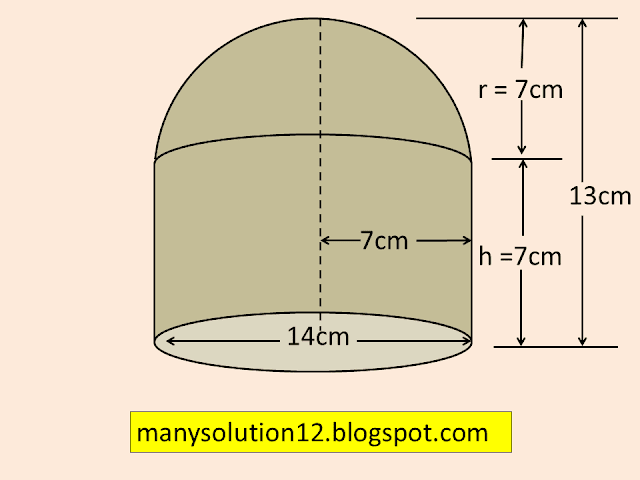

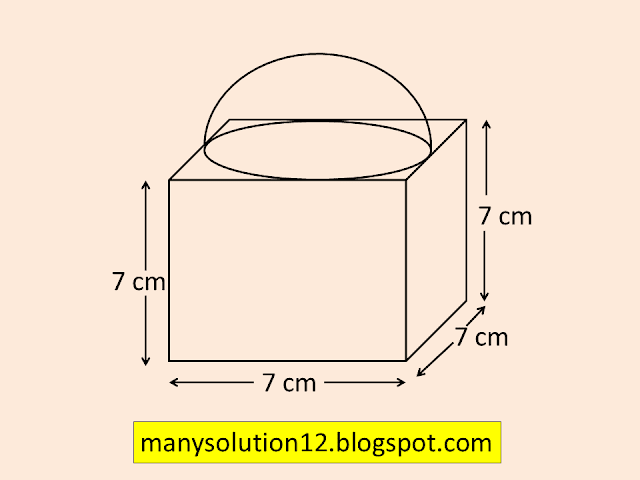
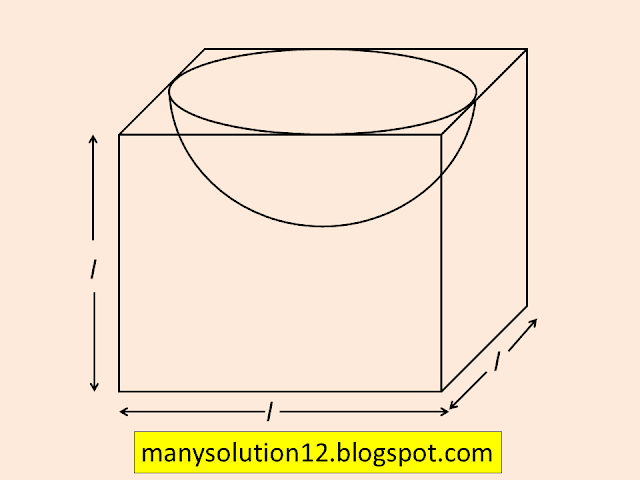
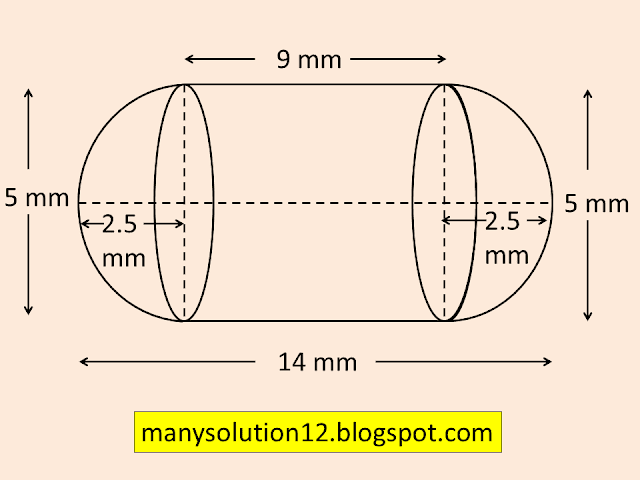
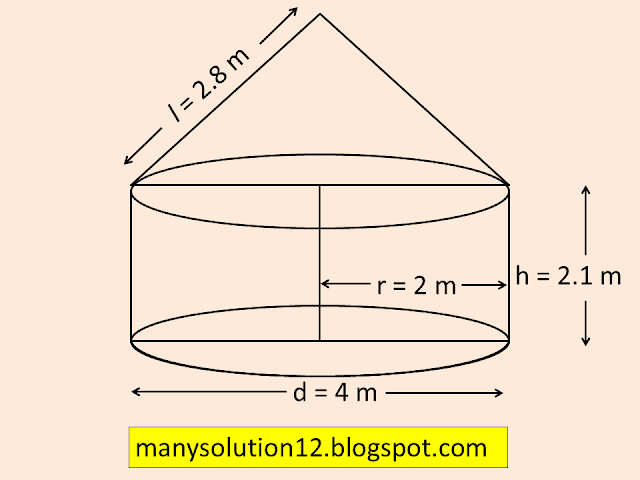
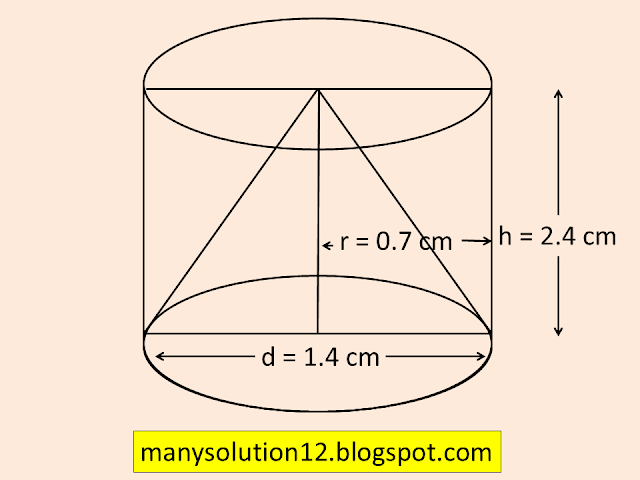
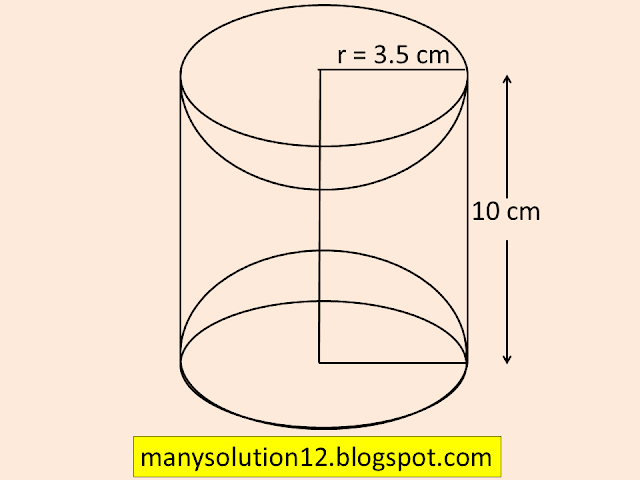


Comments